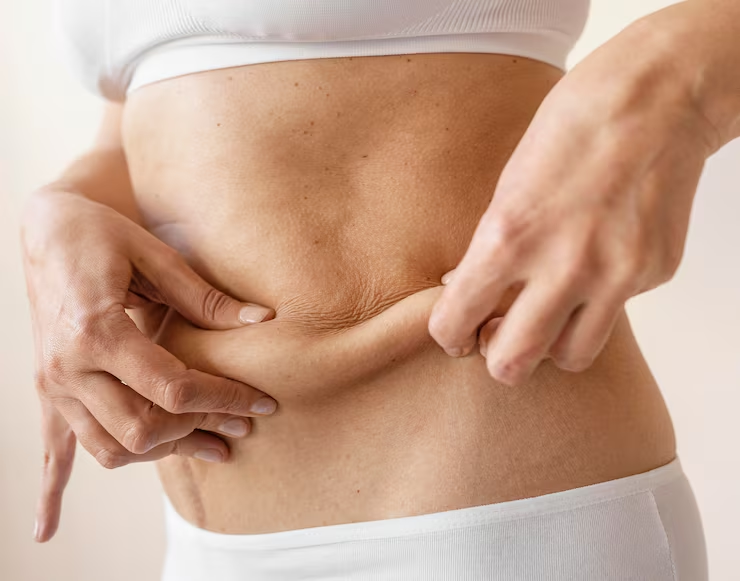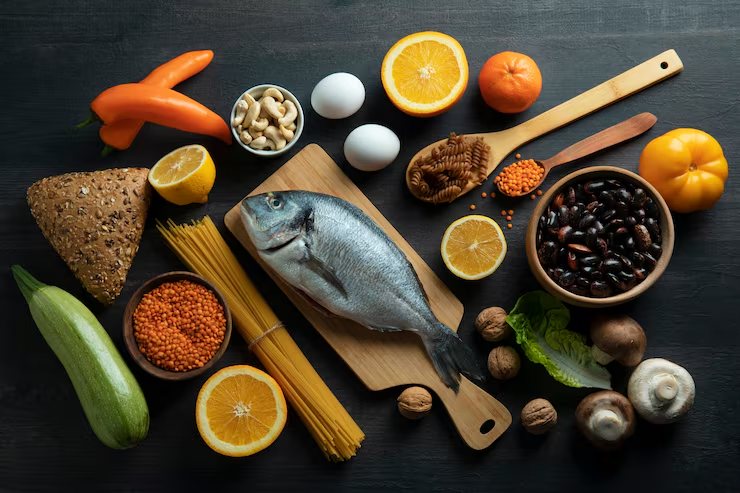Losing weight is a major accomplishment, but many people struggle with loose skin afterward. Understanding how to avoid loose skin after weight loss is essential to maintain a toned, healthy appearance. Rapid weight loss, age, genetics, and lack of muscle tone contribute to sagging skin, which can affect confidence and overall satisfaction with your transformation. Proper planning and care during and after weight loss can help minimize this problem.
To prevent loose skin, it’s important to focus on a combination of nutrition, exercise, hydration, and skin care. Gradual weight loss allows your skin to adapt, while strength training helps build underlying muscle that supports and fills out the skin. Using collagen-boosting foods, moisturizers, and protective routines ensures elasticity is preserved.
Additionally, professional treatments, massages, and maintaining a stable weight can further improve skin tone. By understanding how to avoid loose skin after weight loss, you can enjoy a firmer, more youthful appearance and confidently showcase your results.
What is Loose Skin After Weight Loss?
Loose skin after weight loss is excess, sagging skin that remains when fat beneath the skin is reduced. It often appears in areas like the arms, abdomen, thighs, and face. Understanding how to avoid loose skin after weight loss starts with recognizing that it’s a natural part of body transformation, especially after rapid weight loss or in older adults. Skin elasticity depends on collagen, elastin, hydration, and genetics, which influence how well it adjusts to changes.
This condition is not a sign of failure but a signal that your skin needs support to maintain firmness. Factors like age, the amount of weight lost, and lifestyle habits all affect how your skin adapts. By addressing these factors, you can take proactive measures.
Preventing loose skin requires a combination of gradual weight loss, proper nutrition, exercise, and skin care routines. Knowing what loose skin is helps you implement strategies that keep your body looking toned and healthy.
Why Loose Skin Appears
Loose skin appears because the skin’s collagen and elastin fibers are stretched beyond their capacity. Rapid weight loss, aging, and genetics decrease elasticity, making sagging more noticeable. Understanding how to avoid loose skin after weight loss is important for both aesthetics and overall confidence.
When fat is lost quickly, the skin cannot contract fast enough to match the new body size, leading to flabbiness. Dehydration, poor nutrition, and lack of muscle support worsen the condition. Recognizing these causes allows you to address them through diet, hydration, and exercise.
Addressing the “why” helps guide preventive measures. Strength training, collagen-rich foods, moisturization, and gradual weight loss all counteract the main causes of sagging skin, making it easier to achieve a toned, youthful appearance.
When Should You Take Action?
It’s crucial to focus on how to avoid loose skin after weight loss from the start of your weight loss journey. Waiting until after losing significant weight makes skin tightening more difficult. Preventive strategies are most effective during gradual fat loss.
You should begin hydration, strength training, and skin care routines early. Monitoring skin elasticity and adjusting your diet with protein, collagen, and vitamins ensures that your skin can adapt alongside your body. Skipping this stage often leads to more noticeable sagging.
Taking timely action also allows the skin time to recover naturally, reducing the need for surgical interventions later. Early intervention maximizes the likelihood of firm, toned skin as you achieve your weight loss goals.
How to Prevent Loose Skin Effectively
Preventing loose skin requires a combination of exercise, nutrition, hydration, and skin care. Strength training builds lean muscle that supports the skin, while gradual weight loss prevents overstretching. This is essential for how to avoid loose skin after weight loss.
Nutrition plays a key role; protein, collagen-rich foods, and vitamins like C and E enhance skin elasticity. Hydration keeps the skin plump and resilient. Regular moisturization and exfoliation stimulate blood flow, further improving firmness.
Consistency is key. Pairing these lifestyle habits with sun protection, massages, and maintaining a stable weight maximizes skin elasticity. Following these steps ensures your skin stays toned, firm, and complements your weight loss results effectively.
Top 8 Tips to Avoid Loose Skin After Weight Loss
Lose Weight Gradually
Gradual weight loss is critical in how to avoid loose skin after weight loss. Rapid fat reduction doesn’t give the skin enough time to contract, leading to sagging. Aim to lose 1–2 pounds per week using a moderate calorie deficit combined with balanced nutrition and regular exercise.
By allowing your skin to adjust slowly, you give it a chance to maintain elasticity. Avoid crash diets or extreme fasting methods, as these not only compromise skin health but also affect overall energy and metabolism. Gradual weight loss ensures your body and skin transition together for optimal results.
Pair slow weight loss with hydration, resistance training, and nutrient-rich foods. This approach maximizes the chances of firm, smooth skin. Patients who follow gradual weight loss plans report higher satisfaction and confidence, highlighting the importance of pacing your transformation.
Benefits:
Minimizes sagging and flabby skin
Preserves muscle mass
Reduces risk of stretch marks
Recommended approach:
Balanced diet with moderate calorie deficit
Whole grains, lean protein, vegetables, fruits
Regular exercise (cardio + resistance training)
Incorporate Strength Training
Strength training helps in how to avoid loose skin after weight loss by building lean muscle under the skin. Muscles act as a natural filler, giving your body a firm and toned appearance, reducing sagging. Exercises like squats, lunges, push-ups, and resistance band workouts are highly effective.
Include full-body resistance exercises 3–4 times a week. Gradually increase weights or reps through progressive overload to encourage continuous muscle growth. Strong muscles improve body composition, supporting skin firmness and overall shape.
Combining strength training with cardio ensures fat loss while preserving muscle mass. Adequate protein intake is essential to support muscle growth and skin elasticity. This dual approach enhances your appearance, reduces loose skin, and boosts confidence.
Benefits:
Firms sagging areas (arms, abdomen, legs)
Improves metabolism and fat loss efficiency
Enhances overall body tone
Recommended equipment/ingredients:
Resistance bands, dumbbells, kettlebells
Protein-rich diet: eggs, lean meat, legumes
Creatine (optional, for muscle development)
Stay Hydrated
Hydration is key to how to avoid loose skin after weight loss because water maintains skin elasticity and plumpness. Proper hydration supports collagen production and prevents dryness, which can worsen sagging.
Drink at least 8–10 glasses of water daily and consume hydrating foods such as cucumbers, watermelon, oranges, and leafy greens. Staying hydrated during workouts is especially important, as exercise can deplete fluids.
Avoid excessive caffeine and alcohol, which dehydrate skin. Hydration combined with proper nutrition and skincare routines ensures your skin remains supple, resilient, and more likely to adapt to your weight loss journey naturally.
Benefits:
Improves skin elasticity
Reduces dryness and wrinkling
Supports overall body function during weight loss
Recommended ingredients/foods:
Water, herbal teas, coconut water
Water-rich fruits: watermelon, oranges, grapes
Vegetables: cucumber, celery, zucchini
Eat Collagen-Boosting Foods
Collagen is vital for firm skin. Supporting collagen levels through nutrition is essential in how to avoid loose skin after weight loss. Collagen provides structure, elasticity, and overall skin strength.
Include collagen-rich foods like bone broth, fish, eggs, leafy greens, citrus fruits, and berries. Vitamin C and amino acids in these foods promote collagen synthesis. Collagen supplements or powders may also help if recommended by a professional.
Coupling collagen-rich nutrition with strength training, hydration, and moisturization significantly improves skin elasticity. These habits ensure your skin remains firm, toned, and supportive of your weight loss results.
Benefits:
Enhances skin elasticity
Supports muscle recovery
Reduces wrinkles and flabbiness
Recommended ingredients/foods:
Bone broth, chicken, fish, eggs
Vitamin C sources: citrus fruits, bell peppers
Leafy greens and berries for antioxidants
Moisturize and Exfoliate Regularly
Moisturizing and exfoliating are practical strategies in how to avoid loose skin after weight loss. Moisturizers keep skin supple, while exfoliation removes dead cells and stimulates blood flow, improving elasticity.
Use creams or natural oils like coconut, almond, or shea butter daily. Exfoliate 1–2 times per week using gentle scrubs or dry brushing techniques. Ingredients like hyaluronic acid, retinol, and vitamin E boost repair and firmness.
Consistency is key. Regular moisturizing and exfoliation combined with nutrition, hydration, and resistance exercises helps maintain skin tone and elasticity, reducing the risk of sagging skin after weight loss.
Benefits:
Keeps skin smooth and soft
Stimulates collagen production
Reduces sagging and improves skin texture
Recommended ingredients/foods:
Natural oils: coconut, almond, shea butter
Exfoliants: sugar, oatmeal, coffee grounds
Moisturizers with hyaluronic acid or vitamin E
Protect Skin from Sun Damage
UV exposure breaks down collagen and elastin, accelerating loose skin. Protecting your skin is critical in how to avoid loose skin after weight loss to maintain elasticity and prevent further sagging.
Use broad-spectrum sunscreen with SPF 30+ daily, even indoors near windows. Wear hats and protective clothing when outdoors, and avoid tanning beds. Proper sun protection preserves skin structure and supports long-term firmness.
Combining sun protection with hydration, strength training, and skin care routines ensures a toned, resilient appearance. Healthy skin is more likely to adapt to your weight loss, keeping your body looking youthful and firm.
Benefits:
Protects collagen and elastin
Prevents wrinkles and sagging
Maintains skin health long-term
Recommended ingredients/foods:
Sunscreen with SPF 30+
Protective clothing, hats, sunglasses
Antioxidant-rich foods: berries, green tea, tomatoe
Consider Firming Treatments or Massages
Massages and professional treatments support how to avoid loose skin after weight loss by improving blood circulation, stimulating collagen production, and encouraging natural skin tightening.
At-home options include firming massages with natural oils, while professional treatments like radiofrequency, ultrasound therapy, or laser tightening may help with advanced sagging. Always consult a dermatologist before advanced procedures.
Regular massages, when combined with nutrition, hydration, and strength training, enhance skin elasticity and tone. These practices complement your weight loss efforts, helping achieve firmer, healthier skin naturally.
Benefits:
Boosts blood flow to skin
Encourages natural tightening
Enhances collagen production
Recommended ingredients/foods:
Oils for massage: coconut, almond, jojoba
Moisturizers with vitamin E or retinol
Collagen-supporting foods as listed above
Maintain a Stable Weight
Weight fluctuations weaken skin fibers, increasing sagging. Maintaining a stable weight is essential in how to avoid loose skin after weight loss to give skin time to recover and stay firm.
Focus on long-term lifestyle changes rather than quick fixes. Eat balanced meals, exercise regularly, and avoid yo-yo dieting to keep your weight steady. Gradual adjustments allow skin to tighten naturally.
Stable weight combined with strength training, hydration, collagen nutrition, and skincare ensures your skin remains elastic and toned. This holistic approach maximizes the appearance of firmness and smoothness after weight loss.
Benefits:
Reduces skin sagging over time
Preserves muscle and skin tone
Prevents future flabbiness
Recommended ingredients/foods:
Balanced diet: lean proteins, whole grains, fruits, vegetables
Healthy fats: avocado, nuts, seeds
Hydrating foods: cucumbers, watermelon, oranges
Hydration and Skin Elasticity
Hydration is often overlooked but is critical in how to avoid loose skin after weight loss. Water maintains skin elasticity, supports collagen production, and prevents dryness, all of which are vital for tight, healthy-looking skin.
Drinking 8–10 glasses of water daily, along with consuming hydrating fruits and vegetables like watermelon, cucumbers, and oranges, keeps skin supple. Adequate hydration also aids in nutrient delivery and toxin removal, which improves overall skin health.
Avoid excessive caffeine and alcohol, as they can dehydrate the skin and reduce elasticity. By prioritizing hydration, you enhance your skin’s natural ability to adjust to your new body shape, directly supporting how to avoid loose skin after weight loss.
Nutrition for Skin Tightening
Eating a nutrient-rich diet is key in how to avoid loose skin after weight loss. Collagen-boosting foods like bone broth, eggs, fish, citrus fruits, and leafy greens strengthen the skin from within. Protein intake helps preserve muscle, which fills out the skin and prevents sagging.
Antioxidant-rich foods reduce oxidative stress that breaks down collagen, while vitamins like C, E, and A improve repair and elasticity. Including healthy fats from nuts, seeds, and avocado also nourishes the skin, keeping it firm.
A balanced diet combined with hydration and strength training ensures your skin remains supple, supporting your weight loss efforts while addressing sagging areas naturally.
Skincare Practices to Support Tight Skin
Moisturizing and exfoliating regularly is an essential part of how to avoid loose skin after weight loss. Moisturizers keep the skin hydrated and flexible, while exfoliation removes dead skin cells and stimulates circulation.
Daily application of nourishing creams or oils like coconut, almond, or shea butter enhances elasticity. Exfoliating 1–2 times per week with a gentle scrub or dry brushing promotes skin repair and collagen stimulation.
Incorporating ingredients like hyaluronic acid, retinol, and vitamin E boosts firmness further. Combined with diet, exercise, and hydration, skincare practices ensure your skin adjusts effectively to your changing body shape.
Sun Protection and Skin Health
Protecting skin from UV damage is crucial in how to avoid loose skin after weight loss. UV rays degrade collagen and elastin, accelerating sagging and premature aging.
Always apply broad-spectrum sunscreen with SPF 30+, wear hats, and protective clothing when outdoors, and avoid tanning beds. Proper sun protection preserves skin elasticity and supports recovery during and after weight loss.
Integrating sun care with hydration, strength training, nutrition, and skincare routines ensures a holistic approach to maintaining firm, healthy skin throughout your transformation.
Professional Treatments and Massages
Massages and non-invasive treatments are additional strategies in how to avoid loose skin after weight loss. Massaging the skin improves blood circulation, stimulates collagen, and encourages tightening.
Professional options like radiofrequency, ultrasound therapy, or laser treatments can target stubborn sagging areas, while at-home firming massages with oils improve tone gradually. Always consult a dermatologist before advanced procedures.
When combined with strength training, hydration, nutrition, and skincare, massages and treatments enhance skin firmness and accelerate recovery, helping maintain a toned, youthful appearance after weight loss.
Maintaining a Stable Weight
Finally, maintaining a stable weight is crucial in how to avoid loose skin after weight loss. Yo-yo dieting stretches the skin repeatedly, weakening collagen fibers and leading to sagging.
Long-term lifestyle changes—balanced diet, regular exercise, and consistent hydration—ensure your weight remains steady and your skin has time to adapt naturally.
By focusing on stability, alongside strength training, nutrition, skincare, and sun protection, your skin remains elastic, firm, and better able to complement your new body shape. This holistic approach maximizes your results and confidence after weight loss.
Additional Tips to Maximize Skin Tightening
Massage and Dry Brushing: Stimulates blood flow and encourages collagen production.
Collagen Supplements: Can enhance elasticity when combined with diet and exercise.
Avoid Smoking: Smoking damages collagen and reduces skin repair ability.
Sleep Well: Adequate sleep supports cell regeneration and skin health.
Monitor Progress: Adjust nutrition and exercise based on areas showing sagging.
Conclusion
Achieving weight loss is only the first step; maintaining firm, toned skin is equally important. Understanding how to avoid loose skin after weight loss ensures your efforts reflect positively on your appearance. Gradual weight loss, strength training, hydration, collagen-rich foods, and proper skincare are foundational strategies for preventing sagging.
Supplementing these habits with sun protection, massages, firming treatments, and stable weight maintenance enhances elasticity and overall skin health. With a consistent, holistic approach, loose skin can be minimized, helping you feel confident and satisfied with your transformation.
By focusing on lifestyle habits rather than quick fixes, you promote sustainable results. How to avoid loose skin after weight loss is achievable with patience, persistence, and the right combination of nutrition, exercise, and skin care.
FAQs
1. Can loose skin be completely prevented?
While genetics and age play a role, gradual weight loss, strength training, hydration, and collagen-rich foods can minimize loose skin.
2. How long does it take for skin to tighten after weight loss?
It depends on age, weight lost, and skin elasticity. Most people see gradual improvement over 6–12 months with proper care.
3. Are collagen supplements effective?
Yes, they can support skin elasticity when combined with a healthy diet, hydration, and resistance training.
4. Can loose skin be removed without surgery?
Non-surgical methods like firming treatments, massages, and skin-tightening exercises help, but surgery may be needed for significant sagging.
5. Does hydration really affect skin firmness?
Absolutely. Adequate water intake keeps skin plump and elastic, supporting collagen and preventing dryness-related sagging.



